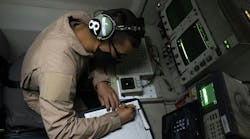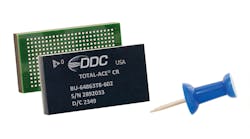Raytheon’s gallium nitride chips meet operational milestone
Gallium nitride (GaN) chips from Raytheon in Tewksbury, Mass., achieved 1,000 hours of reliable operation, moving the technology closer as a standard for next-generation radar. Raytheon engineers have demonstrated the operation of a GaN power amplifier microwave monolithic integrated circuit (MMIC) operating for more than 1,000 hours with no measurable performance degradation. GaN technology provides increased reliability and efficiency, resulting in lower prime power consumption and relaxed cooling requirements, Raytheon officials say. GaN T/R modules provide higher long-pulse radio-frequency (RF) power than that of standard gallium arsenide (GaAs) T/R modules, company officials say. “This milestone enables us to insert GaN next-generation capability into a multitude of air and missile defense programs,” says Pete Franklin, vice president for Raytheon Integrated Defense Systems’ National & Theater Security Programs. “GaN will also give the warfighter significantly more mobility, capability, and reliability on the battlefield. Its ability to run more efficiently than other technologies will help solve many of our customers’ logistical concerns.”
Northrop Grumman demonstrates interoperability between manned and unmanned platforms
Northrop Grumman Corp. in Bethpage, N.Y., demonstrated Joint STARS and E-2 Hawkeye interoperability between manned and unmanned aerial vehicles (UAVs) during a virtual joint military demonstration involving U.S. and coalition forces. The demonstration, Empire Challenge 09 (EC09), was executed by U.S. Joint Forces Command (USJFCOM) and aimed at demonstrating how U.S. and coalition forces can better work together to collect, analyze, and share relevant reconnaissance information. During the month-long exercise, virtual physics-based and operational flight program simulations of multiple Northrop Grumman platforms, including the E-8C Joint Surveillance Target Attack Radar System (Joint STARS) and E-2 Hawkeye Airborne Early Warning and Control (AEW&C) aircraft, worked collaboratively to achieve interoperability between multiple manned and unmanned aircraft via an airborne Web services architecture. One key element to the success of this interoperability was an E-2 Hawkeye developmental test bed, Northrop Grumman officials explain. The test bed is based on the capability of the U.S. Navy’s E-2 Hawkeye mission computing system which enabled it to operate the electro-optical (EO) sensor onboard both manned vehicles and UAVs in response to requests from ground commanders. Using machine-to-machine command interfaces, the E-2 test bed was able to cue each UAV simulator to provide imagery of both static and dynamic ground tracks for target identification. The image request messages were transmitted via machine-to-machine interfaces, replacing the need for voice and manual chat and also resulting in a faster response time. The virtual Joint STARS integrated the Battle Management Command and Control (BMC2) architecture providing constellation management along with UAV control and multi-level security capability sets. The added capabilities enabled the platform to demonstrate an expansion of its current ISR role to include automated UAV image collection and development of target quality solutions to support strike engagements.
Lockheed Martin to support submarine imaging system
The U.S. Navy awarded Lockheed Martin in Manassas, Va., a contract for engineering services and support of the AN/BVY-1 Integrated Submarine Imaging System (ISIS) and for production of related hardware. ISIS revolutionizes Navy submarine surveillance capabilities by integrating digital video and still images from devices on a submarine’s exterior and presenting real-time imagery and analysis on crews’ existing control room tactical displays, Lockheed Martin officials say. “With ISIS, a submarine operator can manipulate a photonics mast with a joystick, while looking at digital video on a computer monitor, and share that video [in real time] with the entire combat team on various displays aboard the vessel,” says Denise Saiki, vice president and general manager of Lockheed Martin’s Undersea Systems business. ISIS also provides submarine operators with additional image enhancement and analysis tools; active and passive range finding control; and recording, storage, and recall options for imagery and associated data.
Lockheed Martin delivers final C-5B Galaxy Transport modified under avionics upgrade program
Lockheed Martin delivered the 50th C-5B Galaxy strategic transport modified under the Avionics Modernization Program (AMP) back to the Air Force. This completes the AMP modifications to the C-5B fleet. Modification of the C-5A fleet continues at Travis AFB and at Dover AFB, Del. Current plans call for the entire 111-aircraft C-5 fleet to receive the AMP modifications. AMP is the first phase of a two-phase modernization effort for the C-5. The AMP modifications replace the earlier analog avionics in the Galaxy with a commercially available, digital avionics suite along with an integrated architecture that allows for upgrades. The entire system is designed to increase safety, ease crew workload, and enhance situational awareness. “AMP takes all the gauges you see in a legacy aircraft and consolidates them,” says Lt. Col. Mike Semo, chief, C-5M Program Integration Office at Dover. “So now, instead of knowing a distance to a certain location, you have a top-down view of where the aircraft is compared to where you’re going. It gives you a lot more situational awareness, which is very important in a combat zone.” A total of 55 C-5 aircraft (50 C-5Bs, two C-5Cs, and three C-5As) have already been through one of the two AMP modification lines.
Northrop Grumman MQ-8B Fire Scout UAV completes RSTA/ISR demonstration
Northrop Grumman’s MQ-8B Fire Scout Vertical Unmanned Aircraft System (VUAS), designated P7, demonstrated its reconnaissance surveillance, and target acquisition/intelligence, surveillance, and reconnaissance (RSTA/ISR) capabilities at Yuma Proving Ground in Yuma, Ariz. This RSTA/ISR demonstration was conducted with the use of a high-magnification electro-optical, infrared (EO/IR) payload, which includes a long-range laser designator and range finder (LR/LD). Full-motion video was relayed down to ground operators in real time over a Tactical Common Data Link (TCDL). After an autonomous launch, Fire Scout demonstrated its ability to find, fix, and track hostile forces during a real-time operational scenario in complex terrain at night. Fire Scout has the capability to support several different RSTA payloads including FLIR System’s BRITE Star II EO/IR/LR/LD, Northrop Grumman’s ASTAMIDS EO/IR/LR/LD (which also provides countermine capabilities), and FLIR System’s Star SAFIRE III EO/IR/LR. Additional payloads can be easily integrated using Fire Scout’s robust open systems modular payload architecture, says a representative. This flexibility also enhances Fire Scout’s ability to support the warfighter. Fire Scout’s RSTA/ISR demonstration highlighted its capability to provide critical real-time RSTA to brigade combat teams (BCT). Fire Scout provides the commander with a view of a selected area across all wavelength spectrums enabling decision-making and integration of soldiers’ actions with supporting BCT fires and effects.
Safety-critical software expert Presagis acquires Seaweed Systems to boost embedded graphics
Presagis officials in Montreal, Quebec, announced that the company has acquired long-standing partner Seaweed Systems Inc. Presagis is a provider of modeling and simulation software solutions. Seaweed Systems, based in Burlington, Mass., is a provider of embedded avionics graphics solutions for the military and aerospace market. Presagis officials in Montreal say the combined solution of VAPS XT and the SeaWind line of OpenGL graphic drivers will deliver timesavings and cost savings to avionics developers, especially when porting and optimizing for specific hardware platforms. As a result of the acquisition, VAPS XT software and Seaweed graphics drivers will now be jointly developed, tested, and optimized to provide the best possible performance across a wide variety of embedded target platforms. End users will also benefit from the fact that their HMI and driver development teams will be integrated—maximizing their efficiency and speeding delivery of embedded applications to market, Presagis officials explain. The acquisition of Seaweed Systems provides Presagis with broader reach into the embedded market through delivery of a more complete offering that will include software, drivers, specialized graphic chips, and consulting services.
Hypertronics connectors provide signal integrity for Northrop Grumman’s Global Hawk UAV
The braking and master flight control computer systems on the Northrop Grumman Global Hawk unmanned aircraft system (UAS) uses KA electrical connectors from Hypertronics in Hudson, Mass. The KA avionics connectors were selected due to their reliability and robustness under harsh environments, shock, and vibration, Hypertronics officials say. Global Hawk can fly at altitudes of more than 60,000 feet for more than 32 hours, and has many potential Earth science and weather monitoring applications, in addition to overseas contingency operations support. The MIL-DTL-55302 QPL’d Hypertronics KA printed circuit board contact system is able to perform at the high heat and elevations required for the UAS. The KAs are available in more than 2,500 model configurations. The system uses 0.60 diameter pins/sockets that are rated at 4 amps with an insertion/extraction force of 1 ounce and for ultimate conductivity are gold(min) over nickel. They are made from corrosion-resistant materials.
Raytheon to acquire Internet inventor BBN Technologies to enhance technology R&D
Raytheon Co. in Waltham, Mass., has agreed to acquire BBN Technologies in Cambridge, Mass., to enhance Raytheon’s capabilities in technology research and development (R&D). BBN developed the ARPANET—forerunner of the Internet—as well as the Boomerang acoustic-based shooter detection system, and other mission-critical military and intelligence systems. BBN specializes in advanced computer networking, speech and language technologies, information technologies, sensor systems, and cyber security. Following the acquisition, BBN Technologies will become part of Raytheon Network Centric Systems (NCS) in McKinney, Texas. “This acquisition will strengthen our positions in networking, communications, video surveillance, and advanced sensing applications,” NCS president Colin Schottlaender states. The transaction is expected to close this fall, subject to closing conditions and regulatory approvals. The transaction is not expected to materially influence revenue or earnings per share for the fourth quarter of 2009, and is expected to be accretive in 2010. Terms of the agreement are not being disclosed.


